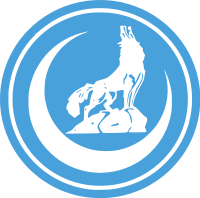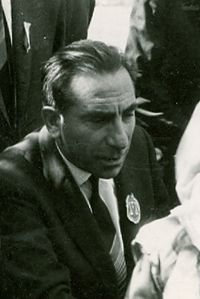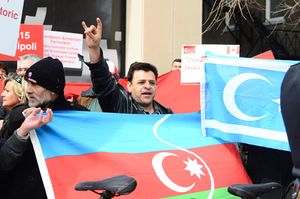الذئاب الرمادية (تنظيم)
| الذئاب الرمادية Grey Wolves | |
|---|---|
| Ülkü Ocakları | |
 شعار الذئاب الرمادية | |
| الزعيم | أحمد يغيت يلدريم(منذ يوليو 2020)[1] |
| تواريخ النشاط | 1968–الحاضر |
| مناطق النشاط | تركيا، قبرص الشمالية، غرب أوروپا، سوريا، الصين، أذربيجان(1992–95؛ حُظرت)، شمال القوقاز (1990s) |
| الأيديولوجية | |
| الموقف السياسي | اليمين المتطرف |
| الأعمال الرئيسية | المذابح، الاغتيالات، التفجيرات[8] |
| الهجمات البارزة | List:
|
| الوضع | نشطة |
| الحجم | |
| سبل الدخل | تجارة المخدرات،[6][8] الابتزاز، الإتجار بالبشر[14] |
| مرتبطة بسلسلة مقالات عن السياسة والانتخاات وجزء منسلسلة المقالات السياسية عن |
| الفاشية الجديدة |
|---|
 |
|
بوابة فاشية بوابة سياسة |
الذئاب الرمادية (تركية: Bozkurtlar، Grey Wolves)،[15] تعرف رسمياً باسم Ülkü Ocakları[16] (تركية: [ylky od͡ʒaklaɾɯ]؛ "الأندية المثالية" أو "المداخن المثالية")،[B]، هي منظمة وطنية تركية. توصف على أنها وطنية متطرفة أو فاشية جديدة.[19][20][21][22][23] تنظيم شباب رسمي على علاقات وثيقة بحزب الحركة الوطنية،[16] يوصف على أنه "ذراع الشباب المسلح" لحزب الحركة الوطنية،[7] "ذراع مسلم غير رسمي"،[24] و"جناح شبه عسكري وإرهابي".[6] أسسه الكولونيل ألپأرسلان توركش في الستينيات، وكان يمثل القوة الوطنية الرئيسية أثناء العنف السياسي في تركيا عام 1976–80. خلال تلك الفترة، أصبح التنظيم "فرقة موت"[25] اشتركت المنظمة في "عمليات قتل وتبادل إطلاق نار في الشوارع".[24] حسب السلطات، 220 قاموا بقتل 694[25][26] من النشطاء والمفكرين اليساريين والليبراليين.[18] كانت الهجمات على طلبة الجامعة شائعة. قاموا بقتل مئات من العلويين في مذبحة مرعش عام 1978[27][28] ويزعم أنهم وراء مذبحة ميدان تقسيم عام 1977.[19][29] العقول المدبرة وراء محاولة اغتيال الپاپا جان پول الثاني عام 1881 بواسطة عضو الذئاب الرمادية محمد علي أگسا لم يتم التعرف عليها، وظل دور المنظمة غامض.[C] بسبب هذه الهجمات توصف الذئاب الرمادية من قبل الباحثين والصحفيين بأنها منظمة إرهابية.[8][30][33][34][35]
كمنظمة وحدوية تركية متشددة، في أوائل التسعينيات وسعت الذئاب لارمادية منطقة نشاطها إلى داخل الدول السوڤيتية السابقة بضم السكان الأتراك والمسلمين. قاتل آلاف من أعضائها في حرب ناگورنو قرةباخ مع الجانب الأذربيجاني، وحرب الشيشان الأولى والثانية على الجانب الشيشاني. بعد محاولة انقلاب فاشلة للاستيلاء على السلطة في أذربيجان، تم حظرهم في البلاد.[36] كذلك قامت قزخستان بحظر المنظمة عام 2005، مصنفة إياها كمنظمة إرهابية.[37][38]
تحت قيادة دولة بهچلي، الذي تولى قيادة حزب الحركة الجمهورية والذئاب الرمادية بعد وفاة توركش عام 1997، أعيد اصلاح المنظمة.[39] بالرغم من هذا، فقد تورط أعضائها في عدد من الهجمات والحوادث العنيفة الموجهة في معظمها ضد الأكراد. كما أن للمنظمة نشاط في الجزء الواقع تحت الإدارة التركية في قبرص. للمنظمة فروع تابعة في مختلف البلدان الأوروپية التي بها أعداد كبيرة من الأتراك، مثل بلجيكا، هولندا، وألمانيا. في ألمانيا توجد أكبر الأكبر[40] منظمة يمينية تضم 10.000 [41] عضو على الأقل ويشار إليها من قبل السلطات على أنها منظمة متطرفة.[42] حسب عالم الاجتماع دوغو إرگيل، كانت الذئاب الرمادية تحظى بدعم 3.6 بالمائة من الناخبين الأتراك في 2014.[12]
الاسم والرمزية

الاسم الغير رسمي للمنظمة مستوحى من اسم الذئبة أسنا في أسطورة إرگنقون القديمة،[43] ترتبط الأسطورة بأصول عرقية توركية في سهوب آسيا الوسطى.[44] في تركيا، يرمز الذئب للشرف.[7] للذئاب الرمادية "تركيز قوي على القيادة أو التنظيم الهرمي الشبه عسكري."[45]
تُعرف الذئاب الرمادية ومدعمي حزب الحركة الجمهورية بإشارة يدهم، والتي تمثل رأس الذئب. الحركة عبارة عن قبضة اليد مضمومة مع رفع أصبعي السبابة والإبهام بشكل مستقيم.[46] إلا أنه، وحسب المعلق محمد علي بيراند، هذه الإشارة ليس مقصورة على أعضاء الذئاب الرمادية.[39]
يستخدم أعضاء الذئاب الرمادية، ما يطلق عليه الباحث أحمد إسنل، "الشعارات الفاشية المستوردة من أمريكا"، مثل "اقبلها أو دعها! (Ya Sev Ya Terk Et!) و"الشيوعيون إلى موسكو" (Komünistler Moskova'ya).[47]
الأيديولوجية
القاعدة
حسب المحلل التركي أنقرلي جان، "معظم الجامعات المرموقة لديها جمعيات ذئاب رمادية - في أكثر الأحيان غير رسمية - لكن سلطتها الحقيقية في الشوارع، بين الفقراء الساخطين في الأحياء التركية ذات الأغلبية السنية."[48]
التاريخ
التاريخ المبكر
حسب روبن سفراستيان، لأن الذئاب الرمادية منظمة خفية، وعادة ما كانت تعمل كمنظمات ثقافية ورياضية، فالمعلومات المتوفرة عنهم نادرة.[49] فقد نفوا مراراً وضعهم كمنظمة سياسية وادعوا أنهم منظمة ثقافية.[50]
عنف السبعينيات وانقلاب 1980
روابط إلى الحكومة التركية وحلف شمال الأطلسي
بعد عام 1980
العنف والنشاط ضد الأكراد
التسعينات
2000s
2010
العنف والنشاط المتصل باليونان
العنف والنشاط المرتبط بالأرمن
أخرى
التواجد في أوراسيا
أذربيجان
الصين
قبرص
روسيا
سوريا
تايلاند
التواجد في أوروبا الغربية
النمسا
بلجيكا
فرنسا
في 2 نوفمبر 2020، أعلن وزير الداخلية جيرالد دارمانان أن الحكومة الفرنسية ستتخذ خلال جلسة لمجلس الوزراء قراراً بحل حركة الذئاب الرمادية القومية التركية المتطرفة. ووجهت أصابع الاتهام الى هذه الحركة بعد صدامات وقعت مؤخرا بين الجاليتين التركية والأرمنية في ديسين-شاربيو قرب ليون. كذلك، كتبت عبارة الذئاب الرمادية على نصب تكريمي لضحايا الإبادة والمركز الوطني للذاكرة الأرمنية قرب ليون في 1 نوفمبر.[51]
ألمانيا
هولندا
السويد
الڤاتيكان
مزاعم تجارة المخدرات غير المشروعة
انظر أيضاً
- إرگنقون (منظمة)
- Vatansever Kuvvetler Güç Birliği Hareketi، جماعة وطنية متطرفة أسسها أعضاء سابقون في الذئاب الرمادية.
الهامش
- المصادر
- ^ 3.6 بالمائة أي حوالي 1.904.188 شخص إذا كان عدد الناخبين المسجلين (52.894.115) في الانتخابات الرئاسية.
- ^ الاسم الكامل: Ülkü Ocakları Eğitim ve Kültür Vakfı (الأندية المثالية مؤسسة تعلييمة ثقافية).[17] يعرف أعضائها باسم Ülkücüler،[7] تعني حرفياً "المثاليين".[18]
- ^ "Mohamed Ali Agca of Turkey, the man who shot at Pope John Paul II in Rome had no political motive. The investigating agency in Italy tried to establish his link with the Turkey based terrorist group, 'Grey Wolf,' however, could not get any evidence of his political connection."[30]
- "The organization also appears to have been involved in the attempted assassination of Pope John Paul II, for Mehmet Ali Agca was a Grey Wolf who in his own confused way mixed Turkish nationalist sentiments with fundamentalist Islam."[31]
- "The Gray Wolves are extreme nationalists accused of being behind the assassination attempt on Pope John Paul II..."[32]
- ملاحظات
- ^ "Ülkü Ocakları'na yeni başkan atandı". Milliyet (in التركية). 7 July 2020. Archived from the original on 28 July 2020.
- ^ خطأ استشهاد: وسم
<ref>غير صحيح؛ لا نص تم توفيره للمراجع المسماةALMo - ^ خطأ استشهاد: وسم
<ref>غير صحيح؛ لا نص تم توفيره للمراجع المسماةMENA - ^ خطأ استشهاد: وسم
<ref>غير صحيح؛ لا نص تم توفيره للمراجع المسماةHunter - ^ أ ب Østergaard-Nielsen, Eva (2003). Transnational Politics: The Case of Turks and Kurds in Germany. London: Routledge. pp. 51–52. ISBN 978-0415265867.
- ^ أ ب ت Atkins, Stephen E. (2004). "Grey Wolves (Turkey)". Encyclopedia of Modern Worldwide Extremists and Extremist Groups. Westport, Connecticut: Greenwood Press. pp. 110–111. ISBN 9780313324857.
{{cite book}}: External link in|contribution= - ^ أ ب ت ث "Crying "Wolf": Why Turkish Fears Need Not Block Kurdish Reform". Europe Report N°227. Brussels: International Crisis Group. 7 October 2013. pp. 9–10.
- ^ أ ب ت Lee, Martin A. (12 April 1998). "Turkish Dirty War Revealed, but Papal Shooting Still Obscured". Los Angeles Times.
- ^ خطأ استشهاد: وسم
<ref>غير صحيح؛ لا نص تم توفيره للمراجع المسماةFOOTNOTEZürcherLinden2004130 - ^ "Thai police look into Turkish connection in Bangkok blast". Reuters. 27 August 2015.
...the most likely perpetrators were members of an ultra-nationalist Turkish organization called the Grey Wolves...
- ^ Sherwell, Philip (29 August 2015). "Bangkok bombing: Was it the Grey Wolves of Turkey?". The Daily Telegraph.
- ^ أ ب Ergil, Doğu (22 April 2014). "Parties and political identities". Today's Zaman. Archived from the original on 19 October 2014.
The Gray Wolves, who are the militant youth wing of the Turkish ethnic nationalists that are dissatisfied with the inertia of the Nationalist Movement Party (MHP) camp, constitute 3.6 percent of voters.
{{cite news}}: Check|authorlink1=value (help) - ^ "Graue Wölfe – die größte rechtsextreme Organisation in Deutschland" (in الألمانية). Federal Agency for Civic Education. 24 November 2017. Archived from the original on 22 July 2020.
- ^ Naylor, R.T. (1999). Economic Warfare: Sanctions, Embargo Busting, and Their Human Cost. Boston: Northeastern University Press. p. 76. ISBN 978-1-55553-499-8.
For the next decade [after the 1980 coup] most operations were conducted from Germany. There, sheltering among the large emigre Turkish community, the Grey Wolves raised money from extortion, alien smuggling and heroin trafficking while attacking left-wing and pro-Soviet targets.
- ^ Jenkins, Gareth (2008). Political Islam in Turkey. New York: Palgrave Macmillan. p. 130. ISBN 9780230612457.
In 1966, Türkeş formed a network of youth organizations called Ülkü Ocakları, or "Idealists' Hearths"; although they and other pro-MHP activists were to become popularly known as Bozkurtlar, or "Grey Wolves," after what Türkeş claimed had been the national symbol of the Turkic peoples in Central Asia. In 1968, Türkeş established more than 100 commando camps scattered across Anatolia, which provided young nationalists with ideological and paramilitary training.
- ^ أ ب "Video shows Turkish police singing Grey Wolf march". Hürriyet Daily News. 25 April 2011.
The Grey Wolves, also commonly referred to as the Ülkü Ocakları (Idealist Hearths), are a youth organization with close links to the MHP.
- ^ "Attack on Sept. 6-7 events photo exhibit condemned". Hürriyet Daily News. 9 September 2005..
- ^ أ ب Idiz, Semih (29 March 2013). "Turkey's Ultra-Nationalists Playing With Fire". Al-Monitor.
- ^ أ ب Sullivan, Colleen (2011). "Grey Wolves". In Martin, Gus (ed.). The SAGE Encyclopedia of Terrorism (2nd ed.). Sage Publications. pp. 236–7.
{{cite book}}: External link in|contribution= - ^ Karasapan, Omer (1989). "Turkey and US Strategy in the Age of Glasnost". Middle East Report (160): 7. doi:10.2307/3013440.
The US also established contacts with the neofascist Nationalist Movement Party and its militants, the Grey Wolves.
- ^ Aslan, Fikret; Bozay, Kemal, eds. (2012). Graue Wölfe heulen wieder: Türkische Faschisten und ihre Vernetzung in Deutschland [Grey wolves howl again: Turkish fascists and their networks in Germany] (in الألمانية) (3rd. ed.). Unrast Verlag. ISBN 978-3-89771-035-1.
- ^ Canefe, Nergis; Bora, Tanıl (2004). "Intellectual Roots of Anti-European Sentiments in Turkish Politics: The Case of Radical Turkish Nationalism". In Çarkoğlu, Ali; Rubin, Barry (eds.). Turkey and the European Union: Domestic Politics, Economic Integration and International Dynamics. Routledge. p. 125, 129. ISBN 9781135761202.
{{cite book}}: Check|authorlink2=value (help) - ^ خطأ استشهاد: وسم
<ref>غير صحيح؛ لا نص تم توفيره للمراجع المسماةCooley - ^ أ ب Combs, Cindy C.; Slann, Martin (2007). "Grey Wolves". Encyclopedia of terrorism. New York: Facts On File. p. 110. ISBN 9781438110196.
The Grey Wolves, the unofficial militant arm of the MHP, has been involved in street killings and gunbattles.
{{cite book}}: External link in|contribution= - ^ أ ب Sloan, Stephen; Anderson, Sean K. (2009). "Gray Wolves". Historical Dictionary of Terrorism. Lanham, Maryland: Scarecrow Press. pp. 213–4. ISBN 9780810863118.
- ^ خطأ استشهاد: وسم
<ref>غير صحيح؛ لا نص تم توفيره للمراجع المسماةGanser - ^ خطأ استشهاد: وسم
<ref>غير صحيح؛ لا نص تم توفيره للمراجع المسماةMarcus - ^ خطأ استشهاد: وسم
<ref>غير صحيح؛ لا نص تم توفيره للمراجع المسماةCengiz - ^ أ ب Prabha, Kshitij (April 2008). "Defining Terrorism". New Delhi, India: Institute for Defence Studies and Analyses.
Mohamed Ali Agca of Turkey, the man who shot at Pope John Paul II in Rome had no political motive. The investigating agency in Italy tried to establish his link with the Turkey based terrorist group, 'Grey Wolf,' however, could not get any evidence of his political connection.
- ^ Pipes, Daniel; Duran, Khalid (August 1993). "Muslims in the West: Can Conflict Be Averted?". Philadelphia and Washington: United States Institute of Peace.
- ^ خطأ استشهاد: وسم
<ref>غير صحيح؛ لا نص تم توفيره للمراجع المسماةIsingor - ^ Slomp, Hans (2011). Europe, a Political Profile: An American Companion to European Politics, Volume 1. Santa Barbara, California: ABC-CLIO. p. 744. ISBN 978-0313391811.
Grey Wolves Turkish terrorist group (Bozkurtlar in Turkish), the youth organization of an extreme right party...
- ^ Farmer, Brian R. (2010). Radical Islam in the West: Ideology and Challenge. Jefferson, North Carolina: McFarland. p. 108. ISBN 978-0786459537.
...a Turkish terrorist group known as the Gray Wolves...
- ^ Carroll, Rory (3 November 1999). "KGB plotted to kill Pope and bug Vatican". The Guardian.
...the Grey Wolves terrorist group...
- ^ خطأ استشهاد: وسم
<ref>غير صحيح؛ لا نص تم توفيره للمراجع المسماةKyamal - ^ "The list of prohibited on the territory of the RK foreign organizations". din.gov.kz. Committee for Religious Affairs of The Ministry of Culture and Sport of the Republic of Kazakhstan.
II. By the judgment of the Supreme Court from March 15, 2005: "Boz Gourde". «Boz Gourde» also known as the «Grey Wolves» is an far right nationalist Turkish militant organization. The basic ideological concept is turanizm (creating a single state of the Turkic peoples).
- ^ Yermukanov, Marat (4 May 2005). "Kazakhstan and Turkey search for common ground". Eurasia Daily Monitor. Jamestown Foundation.
Kazakhstan has officially banned the Kurdish People's Congress and the Turkish nationalist Boz Gurt (Grey Wolves) organization for being "terrorist organizations."
- ^ أ ب Birand, Mehmet Ali (19 May 2006). "You reap what you sow". Hürriyet Daily News.
- ^ Meier, Marcus (16 November 2013). "Graue Wölfe heulen in Oberhausen". Neues Deutschland (in الألمانية).
Die »Grauen Wölfe« sind die mitgliederstärkste rechtsextreme Organisation in Deutschland.
- ^ Baumgärtner, Maik; Diehl, Jörg (15 February 2014). "Türkische Nationalisten in Deutschland: Die unheimlichen Grauen Wölfe [Turkish nationalists in Germany: The Uncanny Grey Wolves]". Der Spiegel (in الألمانية). Archived from the original on 2 November 2014.
In Deutschland sollen mindestens zehntausend Personen zu dieser Szene zählen. [...] Die Grauen Wölfe träumen von der Vereinigung aller Turkvölker zu einer Großtürkei, die vom Balkan bis Zentralasien reichen soll. Die Liste derer, die sie verachten und bekämpfen, ist lang: Kurden, Armenier, Griechen, Juden, Schwule und Christen.
- ^ "Radikale sollen in der NRW-CDU aktiv sein". Die Zeit (in الألمانية). 1 June 2014.
Milli Görüș und Graue Wölfe werden vom Verfassungsschutz beobachtet.
- ^ H. Akin Ünver (April 2009). "Turkey's "Deep-State" and the Ergenekon Conundrum" (PDF). Middle East Institute. p. 2.
The "grey wolf " sign, as well as the unique hand gesture used by Turkish nationalist groups, refers to the she-wolf depicted in the Ergenekon legend.
- ^ Zaman, Amberin (20 April 1999). "Turkey's Gray Wolves Nip at Heels of Power". Los Angeles Times.
- ^ Koutroubas, T., Vloeberghs, W. and Yanasmayan, Z. 2009. Political, Religious and Ethnic Radicalisation Among Muslims in Belgium. MICROCON Policy Working Paper 5, Brighton: MICROCON.
- ^ Matusitz, Jonathan (2015). Symbolism in Terrorism: Motivation, Communication, and Behavior. Rowman & Littlefield. p. 12. ISBN 9781442235793.
- ^ İnsel, Ahmet (7 October 2007). "Amerika'dan ithal faşist slogan". Radikal (in التركية).
{{cite news}}: Check|authorlink1=value (help) - ^ MacDonald, Alex (14 September 2015). "Increasing tensions see resurgence of Turkey's far-right street movements". Middle East Eye.
- ^ Krikorian, Krikor A. (3 October 2014). Փանթուրանական Երազանք կամ «Գորշ Գայլեր». Hairenik Weekly (in الأرمنية).
- ^ "Siirt Ülkü Ocakları Başkanı Yeşilkök". Radikal (in التركية). 2 November 2011.
Siirt Ülkü Ocakları Başkanı Abidin Yeşilkök, "Ülkü Ocakları olarak siyasal bir kuruluş değiliz. Ülkü Ocakları Eğitim ve Kültür Vakfıyız" dedi.
- ^ "داخلية فرنسا: الحكومة ستحلّ حركة "الذئاب الرمادية" القومية المتطرفة التركية". روسيا اليوم. 2020-11-02. Retrieved 2020-11-03.
خطأ استشهاد: الوسم <ref> ذو الاسم "Jacoby" المُعرّف في <references> غير مستخدم في النص السابق.
خطأ استشهاد: الوسم <ref> ذو الاسم "Wangmo&Yazilitas" المُعرّف في <references> غير مستخدم في النص السابق.
خطأ استشهاد: الوسم <ref> ذو الاسم "lefigaro" المُعرّف في <references> غير مستخدم في النص السابق.
خطأ استشهاد: الوسم <ref> ذو الاسم "zvw" المُعرّف في <references> غير مستخدم في النص السابق.
خطأ استشهاد: الوسم <ref> ذو الاسم "derwesten" المُعرّف في <references> غير مستخدم في النص السابق.
خطأ استشهاد: الوسم <ref> ذو الاسم "2013 report" المُعرّف في <references> غير مستخدم في النص السابق.
<ref> ذو الاسم "hurriyet 1998" المُعرّف في <references> غير مستخدم في النص السابق.ببليوگرافيا
- Zürcher, E.J.; Linden, H. van der (2004). The European Union, Turkey and Islam (PDF). Netherlands Scientific Council for Government Policy: Amsterdam University Press. ISBN 90-5356-712-7.
{{cite book}}: Invalid|ref=harv(help) - Avagyan, Ashot, ed. (2013). Պանթուրքական երազանք կամ "Գորշ գայլեր" [Pan-Turkic dream or "Grey Wolves"] (PDF) (in الأرمنية). Yerevan: Asoghik. ISBN 978-99941-2-834-1.
للاستزادة
- Barbara Hoffmann, Michael Opperskalski, Erden Solmaz: Graue Wölfe. Koranschulen. Idealistenvereine. Türkische Faschisten in der Bundesrepublik [Grey Wolves. Koranic schools. Idealists clubs. Turkish fascists in Germany]. Köln 1981, ISBN 3-7609-0648-6.
- Jean-Christophe Grangé: Das Imperium der Wölfe [The Empire of the Wolves]. Bergisch Gladbach 2005, ISBN 3-404-15411-8.
- Poulton, Hugh (1997). The Top Hat, the Grey Wolf, and the Crescent: Turkish Nationalism and the Turkish Republic. NYU Press. ISBN 9780814766484.
- "Graue Wölfe [Grey Wolves]". Jugendkultur, Islam und Demokratie (in الألمانية). Federal Agency for Civic Education. 19 March 2012. Archived from the original on 2 November 2014.
- CS1 التركية-language sources (tr)
- CS1 الألمانية-language sources (de)
- CS1 uses الأرمنية-language script (hy)
- CS1 الأرمنية-language sources (hy)
- Pages using Lang-xx templates
- Pages with plain IPA
- الذئاب الرمادية
- سياسة اليمين المتطرف
- فاشية جديدة
- الإرهاب في تركيا
- قومية تركية
- منظمات وطنية
- حركات وطنية في آسيا
- حركات وطنية في أوروپا
- جماعات متمردة في تركيا
- العملية گلاديو
- منظمات تأسست في 1969
- تأسيسات 1969 في تركيا


